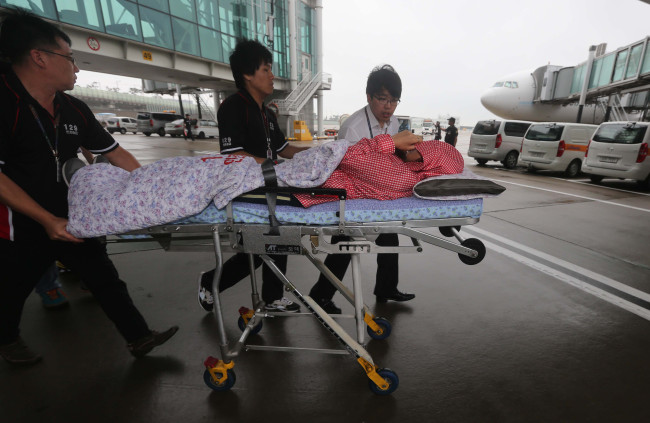Crew tried to abort landing before San Francisco crash
Korean investigators interview pilots; authorities need time to determine cause of crash
By Korea HeraldPublished : July 8, 2013 - 20:12
The doomed Asiana Airlines jetliner that smashed into a seawall bordering a San Francisco International Airport runway Saturday had been flying so slowly that it nearly stalled, U.S. investigators said Sunday, San Francisco time.
The crew made a failed attempt to abort the landing but it was too late, according to a preliminary review of flight data and cockpit communications by the National Transportation Safety Board.
Two Chinese teenage girls were killed and more than 180 people were injured in the crash landing of the Boeing 777 jet that was completing its 11-hour trip from Seoul on Saturday with 307 people on board.
The crew made a failed attempt to abort the landing but it was too late, according to a preliminary review of flight data and cockpit communications by the National Transportation Safety Board.
Two Chinese teenage girls were killed and more than 180 people were injured in the crash landing of the Boeing 777 jet that was completing its 11-hour trip from Seoul on Saturday with 307 people on board.

According to NTSB chairwoman Deborah Hersman, the pilots on board targeted 137 knots, or 254 kilometers per hour, as the plane approached the runway, but the actual speed was much lower.
“We’re not talking about a few knots here or there. We’re talking about a significant amount of speed below 137,” she told reporters.
Hersman emphasized that investigators could not yet draw any conclusions about the cause of the crash, saying: “Everything is on the table right now.”
She added that Korean officials have formally joined the investigation, which is expected to take 12-18 months.
The Korean team, consisting of six Transport Ministry officials and some Asiana staff, arrived in San Francisco early Sunday local time.
They were immediately briefed on the early actions taken by the U.S. authorities and discussed future plans. Two Korean officials plan to participate in studying the Asiana jet’s black boxes that had been brought to the NTSB headquarters in Washington for analysis.
The Korean team also met with the pilots on board who were staying at a hotel near the airport. On Monday, San Francisco time, there would be another joint interview with the pilots and runway traffic controllers, Korean officials said.
On Monday in Seoul, Transport Ministry officials and Asiana Airlines said that Lee Kang-kuk, the pilot in charge of landing the Boeing 777, was in training and it was his first time piloting the long-range plane at the San Francisco airport.
Lee had only 43 hours of experience flying a Boeing 777.
“Lee is a veteran pilot going through what every pilot has to when switching to a new type of plane,” said Choi Jung-ho, the ministry’s aviation policy director.
“He was also helped by copilot Lee Jeong-min, who had more than 12,000 hours of overall flight experience and 3,220 hours with the Boeing 777.”
Choi added it was too early to say whether pilot error or mechanical problems were to blame.
He said that an electronic system called a glide slope indicator, which keeps planes at the proper descent angle, had been turned off at the airport, but airlines, including Asiana, had been told about this.
Of the 291 passengers on board, 77 were Korean nationals, 141 Chinese, 61 American and one Japanese. Many of them, including the two who died, were Chinese teenagers who were arriving for a summer camp to study English.
More than 180 people were hospitalized for treatment, with dozens in critical condition.
By Lee Ji-yoon (jylee@heraldcorp.com)
-
Articles by Korea Herald


![[KH Explains] Why Korea's so tough on short selling](http://res.heraldm.com/phpwas/restmb_idxmake.php?idx=644&simg=/content/image/2024/05/19/20240519050115_0.jpg&u=20240520081646)
![[News Focus] Mystery deepens after hundreds of cat deaths in S. Korea](http://res.heraldm.com/phpwas/restmb_idxmake.php?idx=644&simg=/content/image/2024/05/17/20240517050800_0.jpg&u=)















![[Today’s K-pop] Seventeen to launch new subunit duo](http://res.heraldm.com/phpwas/restmb_idxmake.php?idx=642&simg=/content/image/2024/05/20/20240520050685_0.jpg&u=)